Ingredients: The Herbs & Spices
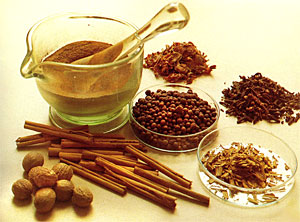
Many of the sources of the natural aromas and flavours of liqueurs can be included under the rather general heading of "Herbs and Spices". And this is probably predictable and to be expected since, as we have observed from the History of Liqueurs, many of our classic styles are based on such botanical products for their flavour and beneficial effect. But here it becomes difficult to isolate for you particular liqueurs flavoured with precise and particular Herbs or Spices. There are of course notable exceptions: Creme de Menthe is obviously made with one. or a variety, of the mint family. Kummel is flavoured. clearly, with the Caraway Seed. But for the rest, they are generally referred to as a "secret blend of herbs, plants and spices". And perhaps this is the way it should be.
Additionally they are frequently used in combination with other ingredients and in very small amounts compared with the total. In short they are now used by Liqueurists as the "pepper and salt" of food cooking, to add zest, piquancy and that little extra bit that lifts and relieves a liqueur which otherwise might be dull or unremarkable. To illustrate in a very simple fashion, what I mean; next time you taste Anisette linger for a moment and explore the range of flavours on your palate. Anisette is one of the classic liqueur styles and based on Aniseed from Europe and Star Anise from China. But if these were the sole flavourings the liqueur would be somewhat too fierce, too hot and too dry for the general run of liqueur enthusiasts and so you will detect a distinct indication of cinnamon which tends to soften the overall effect and lend a richness to the liqueur.
Liqueurists have found over the centuries that the easiest and most convenient way to add the flavours derived from Herbs and Spices is by using their essential oils. An essence is defined in the dictionary as being an extract obtained by distillation or otherwise from a plant and containing its specific properties in a reduced form. Essential oils therefore give us the almost entirely pure flavour of our herbs in a concentrated form. So concentrated in fact that a few drops in 450 litres of liqueur may be all that is required to give the desired flavour change.
There are various methods used to extract these essential oils, one of which I have already described in the chapter on the Flowers. With Herbs and Spices we use Maceration or Percolation, both of which involve the use of a volatile solvent such as pure alcohol, and Steam Distillation.
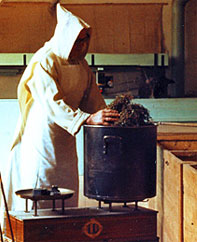 Maceration is a slow and usually cold process and is frequently used where the essential oil to be obtained is unstable to heat. The leaves, stems, dried flowers or bark as the case may be, are steeped for several days in a solution of alcohol. The strength of the solution determines how much of, and what particular essential oils will be extracted from the number of oils present in the base material. In order to obtain maximum extraction the dry material is usually pulverised to give greater surface area. The mixture may be agitated from time to time and it will be tested to determine when equilibrium has been reached and no more extraction is possible. At this point the macerate is filtered off and then possibly concentrated. If the extracted oils are heat stable, a heat distillation process may be used. But if, as is likely, they are unstable the concentration will be done by lowering the pressure above the infusion. The resulting partial vacuum will allow the more volatile spirit to be withdrawn leaving the concentrated macerate behind.
Maceration is a slow and usually cold process and is frequently used where the essential oil to be obtained is unstable to heat. The leaves, stems, dried flowers or bark as the case may be, are steeped for several days in a solution of alcohol. The strength of the solution determines how much of, and what particular essential oils will be extracted from the number of oils present in the base material. In order to obtain maximum extraction the dry material is usually pulverised to give greater surface area. The mixture may be agitated from time to time and it will be tested to determine when equilibrium has been reached and no more extraction is possible. At this point the macerate is filtered off and then possibly concentrated. If the extracted oils are heat stable, a heat distillation process may be used. But if, as is likely, they are unstable the concentration will be done by lowering the pressure above the infusion. The resulting partial vacuum will allow the more volatile spirit to be withdrawn leaving the concentrated macerate behind.
Percolation or infusion, is a much faster and more efficient means of extraction but it is less selective than Maceration. In this process we may either pass a continuous stream of hot spirit through a column filled with the dry ground material, or alternatively we circulate a constant volume of boiling spirit through the material, collect the vapours and recycle until the extraction is complete. This is really a distillation process in a closed system. The final distillate is eventually concentrated by evaporation of the spirit.
In Steam Distillation the herbal material is immersed in water which is brought to boiling point to release the essential oils. These come off as a vapour which is condensed to give natural essential oil.
The result of the Percolation process before concentration may be used directly to make a liqueur simply by sweetening the flavoured spirit which is the final distillate. However nowadays in most producing countries liqueurs are made by compounding-, that is by adding the essential oils and other flavourings to spirit followed by sweetening. This is done to the top secret formulations I spoke of earlier in the history of liqueurs. These recipes not only contain the name of the various component ingredients and the quantities to be used of each, but also the sequence and timing of the compounding. This sequence is vital to the success of a liqueur because if it is not scrupulously followed the resulting product, while not perhaps being a disaster, will be quite inexplicably different- either from what is desired, or from the previous batch of the same liqueur. For instance when high strength spirit is broken down by the addition of water, there is an appreciable increase in temperature. If this is done after the essential oils have been added their nature could be changed and their value reduced. But no matter how careful we may be in the selection of our ingredients and no matter how good our Laboratory controls to ensure that they are of standard quality, outside factors such as humidity, the ambient temperature, and barometric pressure will mean that each compounding will be different from the last. It is the skill of the master liqueurist in the final analysis which goes to ensuring continuity of quality and flavour.
The addition of the sweetening agent, if any is needed, is frequently done last. Sweetening may be a simple solution of pure cane sugar and water or it may be sugar and glucose, or even honey. When this has been well combined with the spirit and flavourings the liqueur is finally put to mature.
 Maturation is a most important part of all liqueur making and while there have been several methods invented to artificially speed up maturation, none have proved to successfully replace the traditionally accepted way of slow quiet rest in oak casks in cool even-temperatured cellars. This time in wood allows all the components of the liqueur to come together harmoniously or "Marry" as the Spirit Trade so quaintly puts it.
Maturation is a most important part of all liqueur making and while there have been several methods invented to artificially speed up maturation, none have proved to successfully replace the traditionally accepted way of slow quiet rest in oak casks in cool even-temperatured cellars. This time in wood allows all the components of the liqueur to come together harmoniously or "Marry" as the Spirit Trade so quaintly puts it.
You may have wondered why we list so many sources for the- same ingredient. England and the U.S.A. are shown for Spearmint for example. This has a simple explanation. The mint is from a different variety in the two countries and even if it were not, the conditions under which it is grown would entail a different flavour in each case. It so happens that we need both flavours in greater or less proportion in order to produce Creme de Menthe to the precise flavour characteristics decided upon. Incidentally "Creme", or cream, on a liqueur label traditionally indicated a spirituous drink that had been sweetened to differentiate it from a dry spirit such as Whisky.
In my history section I mentioned three Liqueurs with a distinctly herbal base: Chartreuse, Benedictine and Absinthe. If we look at some others it is surprising how often aniseed is used. Anisette is obviously the prime one of these. It is mad(-, in most producing countries and called by that name. But it is also called "Anis del Mono" produced in Spain, "Anisetta Stellata" in Italy, "Escarchado" in Portugal when it contains undissolved sugar crystals, "la Tintaine" in France with a branch of Fennel in the bottle. "Mastiche" from Greece and Cyprus and "Ouzo" or "Oyzo" from the same area are either Liquorice or Aniseed flavoured aperitives, being drunk with ice and water, when they turn milky. "Pernod" and "Ricard" are well known brands of pastis which is similar to Oyzo, being consumed in the same way, diluted with water. There are also numerous variations of "Kummel" all predominantly Caraway Seed flavoured.
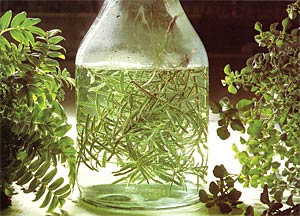 "Fiori Alpini" is one of the most dramatic looking liqueurs made today and its appearance is well matched by its flavour. Based on Alpine herbs, soft, sweet and yellow in colour, it comes in a traditional long-necked clear bottle with a branch of the herb plant in it, on the twigs of which are grown crystals of sugar. We are very proud to be one of very few Liqueur firms in the world to have mastered the secret. "Gold wasser" is another liqueur based on spices and herbs-, cinnamon, coriander, cloves and ginger being among those readily discernible. "Parfait Amour" while relying heavily on flowers for its bouquet and palate is predominately based on spices such as cloves, mace and cinnamon.
"Fiori Alpini" is one of the most dramatic looking liqueurs made today and its appearance is well matched by its flavour. Based on Alpine herbs, soft, sweet and yellow in colour, it comes in a traditional long-necked clear bottle with a branch of the herb plant in it, on the twigs of which are grown crystals of sugar. We are very proud to be one of very few Liqueur firms in the world to have mastered the secret. "Gold wasser" is another liqueur based on spices and herbs-, cinnamon, coriander, cloves and ginger being among those readily discernible. "Parfait Amour" while relying heavily on flowers for its bouquet and palate is predominately based on spices such as cloves, mace and cinnamon.
"Raspail" a recently developed liqueur, relatively speaking since it was only originated in 1847. was nevertheless designed after the classic styles. Its inventor, M. Francois Raspail was convinced of its digestive and medicinal properties using as he did Angelica root, Calamus root and Myrrh amongst others. It is still produced in France.
Most countries have at least one liqueur developed from their native herbs. The Spaniards have "Cuaranta-y-Tres" which is explicit: it is made from forty-three herbs. Russia has a bitter liqueur "Gorny Doubnyak", combining Ginger, Galingale. Angelica, Cloves. Acorns and Oak shavings! "Cocuy" is a Venezuelan liquor, more of a spirit rather than a liqueur, distilled from the Agave or Sisal plant and similar I understand to the Mexican "Tequila". "Enzian" liqueurs are flavoured with the yellow mountain Gentian in Alsace and Bavaria.
The British Isles of course have their famous "Drambuie" and "Glayva" from Scotland, "Irish Mist" from Tullamore in Ireland, "Bronte" from Yorkshire, "Lindisfarne" from Northumberland. These are all spirit based. chiefly Whisky. flavoured with herbs and sweetened with honey. "Strega" is a renowned yellow liqueur made in Italy from. reputedly, more than seventy separate herbs and barks. Jamaica is known for "Monte Aguila", a slightly bitter but excellent digestive liqueur the dominant flavour of which is Pimento or Allspice.
To conclude this chapter I should like to tell you a little story which is a true one and which gave me no little satisfaction when I learnt its details some years after it occurred. It concerns our "Fiori Alpini", of which I spoke earlier. For some time after World War II, when England was trying to get back to normal and because many of the traditional liqueur makers of Europe were unable to supply, Australia was called on for liqueurs and we were one of the firms who exported good quantities to that market. An English writer and maker of liqueurs himself, Mr. Peter Hallgarten, has said, "I recall the superb Australian liqueurs which were imported after the War and which were thoroughly enjoyed . . . "
To ensure that only the best and soundest of liqueurs were exported, the Australian Government declared that all liquers as well as wines and spirits, were prohibited exports unless approved by inspectors appointed by the Customs Department. These inspectors actually were men from the Wine and Spirit trade with trained palates who were relied upon by the Department to say what was, and was not, sound merchantable quality in the way of exports.
On one occasion we had submitted a sample of "Fiori Alpini" for approval and the Inspector, then a young man and now one of my good friends, was not happy about its quality. He asked, as was proper and correct, for a fresh sample to be obtained which the Customs official undertook to do. The Customs man, however, knew his business and also asked an importer of Italian "Fiori Alpini" to submit a sample of his imported product. In the following week the Customs officer called the original inspector to his office in the company of the importer, who was also an approved inspector, and confronted them with three masked bottles all containing "Fiori Alpini", two of which were Baitz and one imported. After some time, the young inspector declared himself as unable to say which of the three samples he had initially rejected, on the grounds of low strength and low flavour, while the importer was also quite perplexed as to which of the three was his own. We got our approval to export and incidentally gained a firm friend because although he did not know at the time, the young inspector was told by the Customs official some months later it had been a Baitz product he had at first rejected. Now, nearly twenty years later, the 'young' inspector is middle aged but still deeply involved in tasting and talking about liqueurs, and I am sure recalls this incident with rueful amusement. I feel, in fact I know, he would now agree that it is foolish, if not downright dangerous, to adopt too positive a stance on anything so very personal and ephemeral as a first-blush impression of a product as complex as a liqueur.
Extraction of Herbs & Spices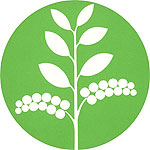
The fascination of wild and exotic herbs and spices has intrigued man throughout the ages Herbs and Spices not only have unique flavouring characteristics but also have many varied remedial and medicinal properties. In this role they formed the basis of most of the early day liqueurs. Today they play a major role on the palette of the master liqueurist. The selection and refinement of these delicate and diverse flavours is a difficult, complex and creative art. There are several ways in which their extraction may be done and our diagram shows two of these, Maceration and steam Distillation, of which the latter is now most frequently used.
GRINDING AND CRUSHING. The fresh or dried Herbs and Spices are crushed and teased apart to burst open the oil cells and to allow an easy and deep penetration of the solvent.
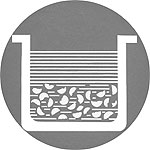
MACERATION. The ground material is macerated or soaked in an alcohol mixture for several days or weeks (depending on the variety being processed) to break up and dissolve the flavour components.
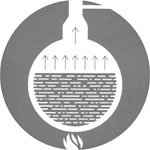
FLAVOUR CONCENTRATION. After being filtered the macerate is transferred to a Concentrator (as in the diagram) where heat evaporates the solvent leaving the oil behind. If the oil is heat sensitive, the solvent will be removed under vacuum at low temperature.
Alternatively...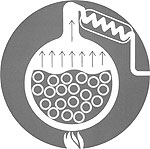
STEAM DISTILLATION. The ground material is placed in a Still together with water. When the water is heated to boiling, the essential oils are released and taken up in the steam to be condensed into a receiver.
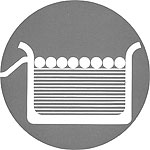
OIL RECLAMATION. The condensate is left to stand for some days in the glass lined receiving vessel and the essential oils separate, out to float on the surface where they can be easily removed. If they are uncomplicated flavour oils they can be used at this stage after drying. If however they are complicated-, that is, several oils present together, they can be separated in the next process.
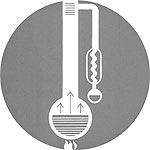
FRACTIONAL DISTILLATION. The oils are taken to a Fractionator where they are redistilled and as they rise up the column they can be accurately separated by their differing evaporating temperatures. In this process the bitter tasting and unwanted fractions can be isolated and removed.
